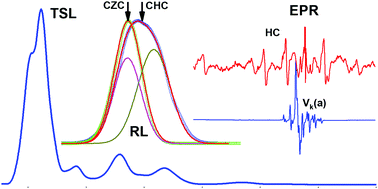Correlation of emission, scintillation and charge trapping properties in Cs2HfCl6 and Cs2ZrCl6 single crystals
Abstract
Cs2HfCl6 (CHC) and Cs2ZrCl6 (CZC) single crystals were grown by a vertical Bridgman method. Luminescence and charge trapping properties were studied in CHC crystals by the correlated measurements of electron paramagnetic resonance (EPR), radioluminescence (RL) and thermally stimulated luminescence (TSL) techniques. CZC crystals were studied by the same set of measurements in order to find correlations between CHC and CZC crystals. EPR spectra measured before and after X-ray irradiation in both CHC and CZC samples were attributed with the typical signals of the Vk(a) hole trapping center (Cl2− pseudomolecular ion), which has recently been reported though the magnitude of the signal was much smaller in the CZC crystal. Besides the Vk(a) signal, another spectrum was observed in both samples; however, its intensity was at a very low level. It has been tentatively ascribed to the complex HCl-related hole trapping center. TSL glow curves measured in both CHC and CZC samples within the 10–500 K temperature range were composed of 6–8 complex peaks. The dominating peak at about 100–120 K originates from the de-trapping of holes at the Vk(a) trapping center. Scintillation characteristics of CHC crystal were studied over the temperature range of 9–295 K. Scintillation decay curves were fitted by three components. The CHC crystal demonstrated a much similar light yield of ca. 20 500 ph per MeV at room temperature and 9 K. The temperature dependence of the scintillation light output exhibits an unusual s-shaped character with the drop at around 100 K that correlates well with the decrease in the Vk(a) EPR signal, evidencing detrapping of holes trapped at the Vk(a) center in the CHC crystal. Therefore, the Vk(a) center was assumed to be the part of Hf3+–Cl2− self-trapped exciton (STE) that participates in the emission above 100 K becoming “frozen” below 100 K. RL and TSL spectra were complex in the CHC sample composed of two and three overlapping bands, respectively. One of the components peaking at 2.65 eV originated from the Zr-related STE.



 Please wait while we load your content...
Please wait while we load your content...